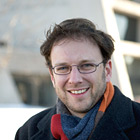From the editor: Planning complements the next big accelerators
 |
The startup of the Large Hadron Collider (LHC) is imminent, and much of the particle physics community's attention has shifted to Geneva, Switzerland. Looking even further ahead, physicists plan to use the International Linear Collider to answer the next big questions in the field. The ILC's Reference Design Report, a major milestone in planning the ILC, is due out in draft form in February 2007.
This fervid planning makes it easy to overlook the significant progress of currently operating experiments, and how much more they can achieve even before the LHC turns on. In this issue of symmetry and the next, we look at the prospects of the large particle collider experiments going on right now. Their discoveries will be the stepping stone for research done at the LHC and ILC.
The Tevatron collider is repeatedly breaking its own records for luminosity, producing numerous physics results. Conventional wisdom says that the Higgs will be discovered at the LHC. But the observation of a rare process called WZ production at the Tevatron has raised the possibility of observing the much-sought Higgs boson in the next couple of years. Meanwhile at the B factories, hints of new physics, potentially indicating supersymmetry or some other new phenomenon, keep showing up. More time is needed to establish firm results.
Where do we go from here? The particle physics community has devised a plan to achieve the best possible research program. In October, the Particle Physics Project Prioritization Panel (P5) released its “Particle Physics Roadmap,” providing strategic advice on a comprehensive program. Its guide to the next five years presents full LHC operation and R&D for the ILC as the highest priority. The set of priorities also includes research activities in neutrino physics and astrophysics that broaden the approach to answering the most important fundamental physics questions.
The roadmap is consistent with the recommendations of the EPP2010 report released by the National Academy of Sciences earlier this year. Now the particle physics community must engage funding agencies and the public to convince them of the great value of the enterprise.
David Harris, Editor-in-chief
Click here to download the pdf version of this article.


